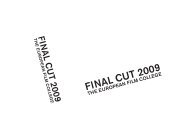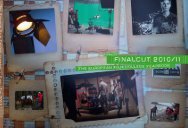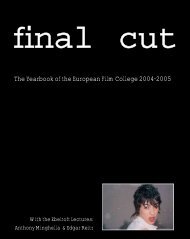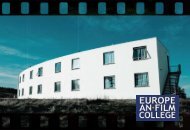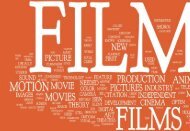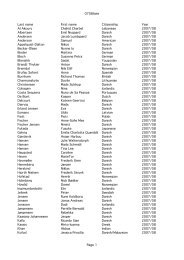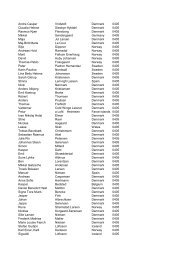yearbook 2004/05 - The European Film College
yearbook 2004/05 - The European Film College
yearbook 2004/05 - The European Film College
You also want an ePaper? Increase the reach of your titles
YUMPU automatically turns print PDFs into web optimized ePapers that Google loves.
the creator to the reality in front of<br />
the camera (whatever that camera<br />
might be) and from there, through<br />
the lens, onto the imaging media:<br />
CCD and tape, negative film, reversal<br />
film, digital image or Polaroid<br />
photo:<br />
Where are the “dangers”? What<br />
can go wrong and destroy the<br />
“beautiful concept”? Unfortunately<br />
no one has the whole secret.<br />
I have parts of this secret and we<br />
will try to unveil it together.<br />
How real is the reality<br />
This will be a journey into the<br />
world of cinematographers. What<br />
do they need to know and do in<br />
order to control the reality and<br />
bring it on to the screen. What<br />
does it take to make three painted<br />
walls in a studio look like an Italian<br />
palace. How much physics,<br />
chemistry, history of painting and<br />
psychology do you need to know<br />
in order to create inexistent realities.<br />
<strong>The</strong> course deals with strategies,<br />
approaches, solving problems<br />
imposed by the requirements of<br />
the script, <strong>The</strong>re would be a special<br />
emphasis on lighting both<br />
theoretically and practically. At<br />
the end of the course the students<br />
will do the lighting for a “live-totape”<br />
video production of a music<br />
show.<br />
Animation<br />
Designed on a workshop structure,<br />
the course aims at producing<br />
a short (max. 90 seconds) animation<br />
movie as a model to learn<br />
what animation is all about; as<br />
projects will take shape, students<br />
will deal with specific problems<br />
ranging from building sets or puppets<br />
to lighting and filming.<br />
- time and space in frame by frame<br />
mode<br />
- survey and techniques available<br />
- timing and spacing - a must for<br />
metering the movement<br />
- “pencil test”: a tool for controlling<br />
the illusion,<br />
assignments<br />
- pitching the projects<br />
- production<br />
Allan Kartin:<br />
Editing and Audio-<br />
Visual Techniques<br />
Danish. Qualified as an electrician<br />
and started work in the radio and<br />
TV department of the royal Danish<br />
Post and Telegraph. 1968:<br />
qualified as an electronics engineer<br />
from the Technical Institute<br />
of Copenhagen. 1972: joined<br />
Scandinavian Airlines to work<br />
with navigational and communication<br />
equipment in aeroplanes.<br />
1974: joined a Trans-Pacific expedition<br />
as the radio operator, diver<br />
and navigator aboard a replica of<br />
a 2000-year old Chinese junk.<br />
1976: studied information technology<br />
at the Danish Institute of<br />
Technology. 1978-1993: senior<br />
technical consultant, itineran<br />
troubleshooter and instructor at<br />
Radiometer International Ltd.<br />
Produced and edited the com-<br />
pany’s instruction and promotion<br />
videos. 1993-95: taught editing<br />
and media technology at the EFC,<br />
subsequently working as a guest<br />
teacher and technical consultant<br />
before rejoining the staff full-time<br />
in 1999. 1995: was given a grant<br />
by Nordisk <strong>Film</strong> to develop the<br />
“gyrocam”, a gyrostabilised camera<br />
system designed for steady filming<br />
from unstable vehicles, and<br />
founded a company specialising in<br />
aerial filming. He has credits as an<br />
aerial photographer on a number<br />
of feature films, including Lars<br />
von Trier’s <strong>The</strong> Kingdom. Allan<br />
is a licensed pilot, diver and ship’s<br />
master.<br />
Courses: Basic AVID editing<br />
This course enables you to do<br />
basic nonlinear editing on the<br />
AVID-Express.<br />
We will briefly go through the<br />
necessary field to enable you to<br />
work alone on the Avid systems.<br />
You have to practise outside class<br />
hours.<br />
WHO´s WHO<br />
- Basic nonlinear editing<br />
- Cuts and dissolves<br />
- Titles and credits<br />
- Logging and digitising<br />
- Output to master tape<br />
Litsa Boudalika:<br />
<strong>Film</strong> and<br />
TV Documentary<br />
Greek/Belgian. Born in Greece,<br />
Litsa moved in her teens to Belgium<br />
and subsequently to Italy,<br />
where she studied Cinema and TV<br />
Directing at the Centro Sperimentale<br />
de Cinematografia in Rome.<br />
In 1986: following her graduation,<br />
she returned to Brussels and later<br />
moved to Paris, where she began<br />
work, first as an assistant on feature<br />
films and commercials, later<br />
as a film director and producer of<br />
short and medium-length TV documentaries.<br />
Litsa has made films<br />
for a variety of <strong>European</strong> channels,<br />
including RTBF, BRT (Belgium),<br />
France 2, France 3, Arte, Image+<br />
(France), ET-1 (Greece), NPA<br />
(the Netherlands), SVT (Sweden),<br />
TSR, TSI (Switzerland), Channel<br />
2 (Israel) and others. In 1995 she<br />
trained as a producer with EAVE<br />
under the MEDIA Programme of<br />
the <strong>European</strong> Union, and has subsequently<br />
specialised as a trainer in<br />
media herself, last year attending<br />
the Department of Education at<br />
Universit’e Paris 2. Before joining<br />
the EFC, she worked as an international<br />
trainer in the audiovisual<br />
world.<br />
Courses: “As far as I can see”<br />
<strong>The</strong> course approaches the documentary<br />
as a genre based on observation.<br />
“Seeing” is what the<br />
students are encouraged to do in<br />
their practical exercises as well.<br />
Can one see and make a story out<br />
of that observation? If yes, what<br />
is the film language to use for it?<br />
<strong>The</strong> “observational” being also a<br />
specific documentary genre, ex-<br />
amples from that style of films are<br />
also extensively analysed. <strong>The</strong><br />
course implies reading, writing<br />
and working on several short exercises,<br />
individually and collectively.<br />
Portraits, Landscapes and Still<br />
Lifes in Documentary After a<br />
short introduction to the origins<br />
of the genre, the course explores<br />
the documentary by using a metaphor<br />
from the world of painting.<br />
It analyses examples of (film- or<br />
video-) portraits. Is the division<br />
into landscapes and still lifes still<br />
applicable? Through examples of<br />
films, study and some practice, the<br />
students also start to be familiar<br />
with the today¹s landscape of documentary<br />
(variety of topics, formats,<br />
marketplaces). <strong>The</strong> course<br />
implies active participation from<br />
each student (reading, viewing,<br />
commenting writing and working<br />
in small groups). It includes<br />
collective short exercises on paper<br />
and in video as an introduction to<br />
the process of writing and making<br />
a documentary.<br />
Documentary “Seen on TV”<br />
<strong>The</strong> course defines the documentary<br />
genre inside its larger media<br />
environment (mainly <strong>European</strong>).<br />
Television of the past days is evolving<br />
towards new forms of transmission<br />
and programming such as<br />
regional or thematic channels, web<br />
TV’s ... In this TV landscape of<br />
contant motion, what is the living<br />
space for the documentary? What<br />
“new” forms do we witness and<br />
what ancient models, if any, do we<br />
still adhere to? Key-roles in making<br />
documentary are described<br />
and analysed through existing<br />
examples: from the decision maker’s<br />
expectations to the audience’s<br />
- large or tiny - point of view. In<br />
this way, the editorial and budget<br />
aspects - either for national or international<br />
co-productions - appear<br />
as the key-points of documentary<br />
production or creation.<br />
From Seeds to Screen<br />
Here we are concerned with the<br />
whole process of directing a documentary,<br />
either an original or a<br />
commissioned project.<br />
1. From the idea (or concept)



